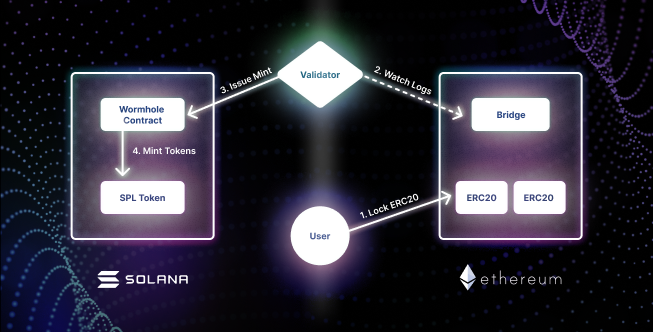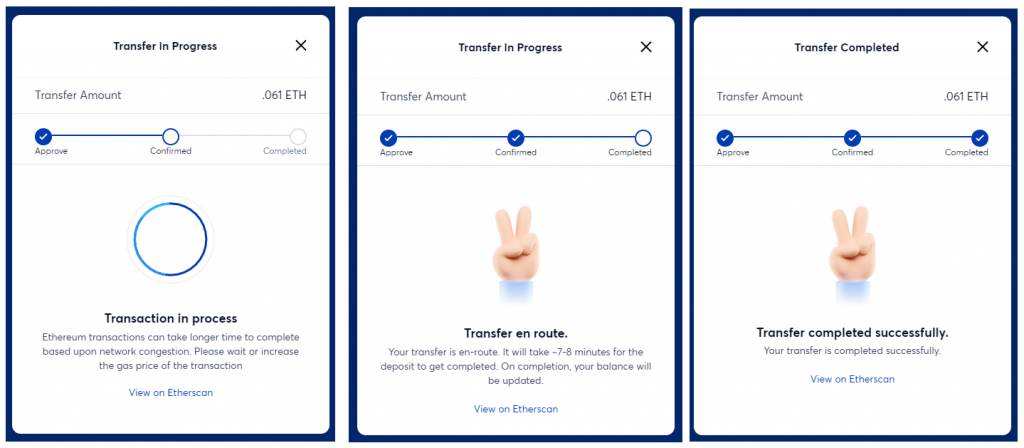Blockchains operate in accordance with unique protocols, rules and governance models. For blockchains to cross-communicate, solutions called bridges are necessary. Bridging solutions make it possible for otherwise disparate blockchains to interoperate.
Loosely speaking, bridges let you use cryptocurrencies or tokens on blockchains to which they are not native. (This involves something called ‘wrapping’. More on this in ‘What Is Tokenised BTC On Ethereum?’.)
The designs and security of bridges vary greatly. Centralised bridges depend on a trusted party or parties, whereas trustless bridges depend on code to execute cross-chain transfers.
How Do Blockchain Bridges Work?
If you own ETH on Ethereum and want to use it on the Polygon network, for example, you must send it across via a bridge.
A bridge automates this procedure and guarantees the ‘locking’ and ‘unlocking’ of tokens on either side of the bridge. The bridging process essentially ‘locks’ the ETH on the native Ethereum network via a smart contract or trusted network participant. Another smart contract then ‘mints’ an equal number of ETH represented on Polygon.
As a 1-to-1 bridge, only one or the other can be unlocked. Since smart contracts are automating these transfers, a double spend is highly unlikely to occur. One way that bridges make sure of this is to use ‘checkpoints’ or other labels for milestones. For example, waiting at least 10 confirmations for the initial deposit of ETH into the blockchain bridge smart contract ensures that the ‘minting’ smart contract can proceed safely.
Because of this, bridging solutions can take several minutes to hours in order to fully process a request. (See this blog post if you’re interested in reading more about blockchain bridges.)

Sidechain Bridges
Whilst blockchain bridges connect two completely different blockchains, sidechain bridges connect a ‘parent’ or ‘main’ blockchain (e.g. Ethereum or Bitcoin) with its ‘child’ or ‘side’ chain. Ronin and xDai are examples of sidechains. Each of them are maintained by a set of validators and periodically reference the Ethereum blockchain.
Most Widely Used Bridge Solutions
Bitcoin and Ethereum are layer-1 (L1) blockchains. People usually want to represent these in layer-2 (L2) blockchains or sidechains. Whilst many L1↔L2 bridges exist, there few L2↔L2 bridging solutions. This will become possible as bridging technologies advance.
How to set up a custom RPC
MetaMask is a widely used wallet that has bridging capabilities as it allows users to add custom Remote Procedure Call (RPC) networks that open access to L2 blockchains. (See this Daily Post by Nathan for more on setting up custom RPCs on MetaMask.)
Solana
Sollet is the native web-based Solana wallet that has bridging features built-in for bridging between Ethereum and Solana. Using Sollet wallet offers a more decentralised method of bridging.
Similarly, the SOLAR Bridge links between Solana and Arweave, and made Solana the first blockchain to move and store its transaction history on a dedicated storage network.
Polygon
Polygon provides 2 separate ways for moving assets from Ethereum and Polygon: the plasma bridge or proof-of-stake (PoS) bridge.
Plasma bridge provides increased security guarantees due to the plasma exit mechanism. However, there is a 7-day withdrawal period on all exits which is caused by certain restrictions in the plasma architecture.
The PoS bridge is secured by a robust set of validators who are elected by MATIC token holders and are granted the authority to stake their Ethereum in order to be a validator. These validators are punished harshly if they act in a non-secure manner or risk the bridge’s integrity.
Polygon Web Wallet v2 is the most commonly used solution for bridging to Polygon.

Bridge Solutions for Other Blockchains
Binance Bridge is a bridge service providing access to inter-blockchain liquidity for Binance Chain and BSC dApps. The withdrawal options with Binance allow you to withdraw compatible cryptocurrencies to Ethereum or BSC networks. There is also a dedicated bridging website for non-Binance users to use.
The Avalanche–Ethereum Bridge (AEB) connects directly to your MetaMask wallet for easy transfers of Avalanche and Ethereum assets between blockchains. In order to transfer AVAX to Ethereum, AVAX must be wrapped into WAVAX—this represents AVAX 1:1 and conforms to the ERC-20 token standard.